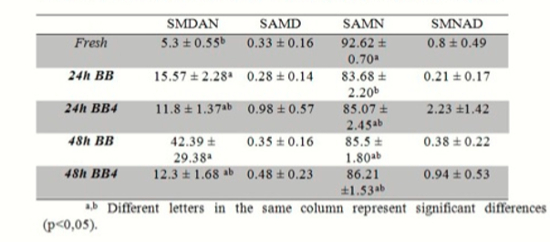Use of Docosahexaenoic Acid to Prevent Acrosomal and Sperm Membrane Integrity in Domestic Cat Cooled Spermatozoa - Preliminary Results
Department of Animal Reproduction and Veterinary Radiology, UNESP, Botucatu, Brazil
Introduction
Cryopreservation of semen is an important tool for semen conservation; however, damage to spermatozoa and acrosomal membrane may occur due oxidative stress. To overcome this issue, the addition of antioxidants prior to cryopreservation has been used.1,2
Objectives
We aimed to evaluate integrity of sperm and acrosome membrane from domestic cat cooled semen extended with or without addition of antioxidant.
Methods
Six semen samples were collected (three from cat A, two from B; one from C) using artificial vagina technique. Semen was divided in 2 aliquots and each one was diluted. BB: Botubov® (Botupharma, Botucatu, Brazil) and BB4: Botubov® add with docosahexaenioc acid (0.04 mg); to a final sperm concentration of 40 x 106/ml and cooled at 5°C for 48 h. For sperm and acrosomal membrane integrity an association of propidium iodide (Pl; P4170, Sigma Aldrich), FITC-PSA (L0770, Sigma Aldrich) and Hoechst 33342 (14533, Sigma Aldrich), was performed using a C11-BODYPY (D-3861, Molecular Probes Inc., Eugene, Oregon, USA) using flow cytometry. Normality test was performed using Kolmogorov-Smirnov (K-S), ANOVA followed by Tukey using GraphPad Prism 6.
Results
Results are described in Table 1.
| Table 1 | 
Sperm membrane damaged and acrosomal normal (SMDAN); sperm and acrosomal membrane damaged (SAMD; sperm and acrosomal normal (SAMN); sperm membrane normal and acrosomal damaged (SMNAD) in fresh and cooled (24 and 48 h) cat semen extended with Botubov® added (BB4) or not (BB) with antioxidant. |
|
| |
Conclusions
Apparently the addition of docosahexaenoic acid in the extender had a benefic action and helped prevent sperm and acrosomal membrane damage, however it is necessary to increase the number of samples to confirm this result.
Financial support: FAPESP.